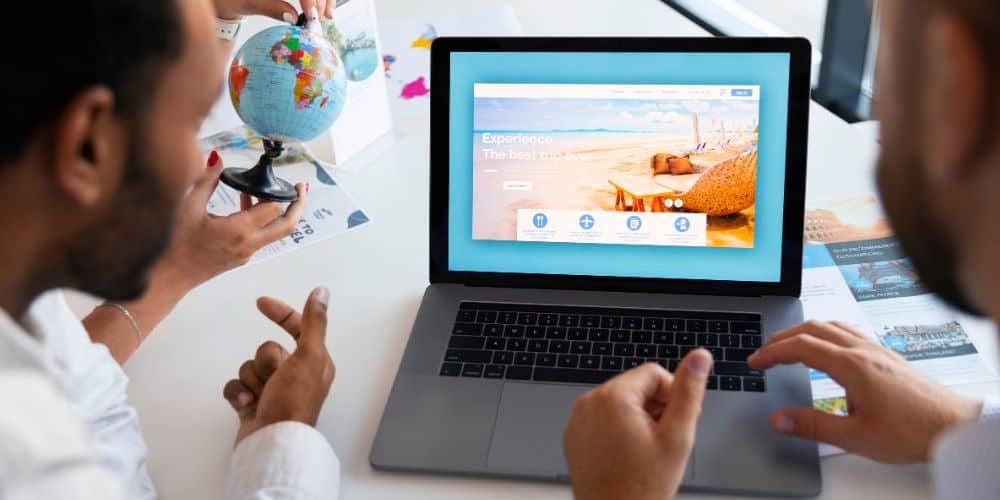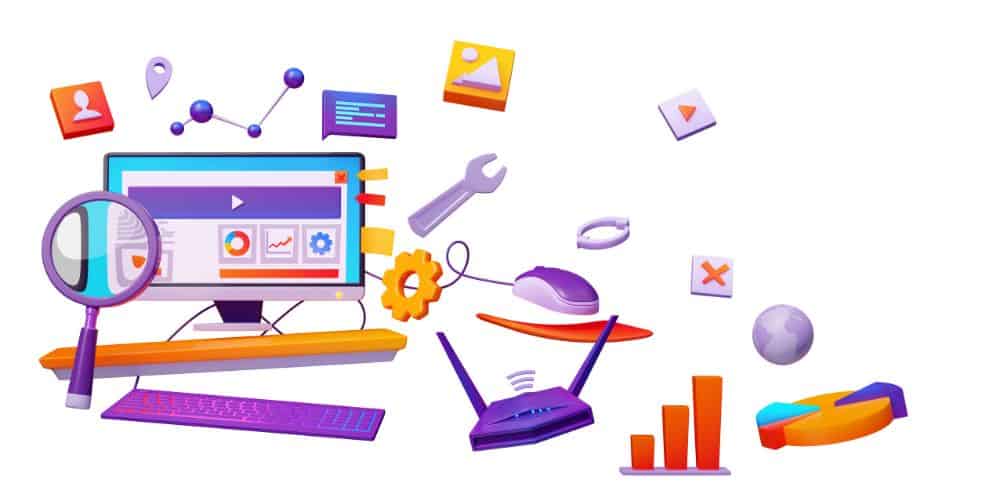
You have a business website and you want it to rank well in search engines. Search Engine Optimization (SEO) is the best way forward. But most businesses think SEO is just about stuffing keywords into their website. So what’s the reality? Search engines actually look at two main things when deciding which websites to show first. What’s on your website and what others say about your website. The first part is called on-page SEO. The second? That’s off-page SEO.
On-page SEO covers the basics. This includes your content quality, page speed, website design and keyword placement. Once you nail these fundamentals, off-page SEO takes over as your growth driver.
Off-page SEO means taking actions outside your website. The actions you take to build authority and credibility. The biggest factor here? Getting backlinks from other trusted websites. It’s not just about pasting your website URL randomly on different sites on the internet. You need backlinks from quality sites.
We’re going to talk about off-page SEO and natural link building in detail in this guide.
What is Off-Page SEO?
Off page blog is about boosting your website’s reputation outside your own site. You can tell everyone your product is great, but it means more when others say it. It’s great when customers, industry experts, or popular websites vouch for you. That’s essentially what off-page SEO does for your website. It includes getting backlinks, mentions, and shares from other trusted websites.
Here’s a simple breakdown:
Say you run a real estate business in Brampton. A popular property blog writes an article about “Best Real Estate Agents in Brampton” and links to your website. Now when search engines see your website link on this blog, they may consider your business trustworthy. They rank you higher. If a trusted industry publication links to your blog post, search engines think “this must be useful content” and rank you higher.
More visibility means more customers finding you organically.
Off-page SEO doesn’t just boost rankings. It puts your brand in front of new audiences. More people tend to click on your website link when its available on other sites. Building these connections takes time and strategy. You can’t buy these links simply because that’s not ethical way. You need links from websites that actually relate to your industry. A random link from anywhere won’t help much.
Many businesses partner with an experienced SEO marketing agency to handle outreach and build these valuable connections.
What is Link Building? The Core of Off-Page SEO
Link building means getting other websites to link back to yours. Sounds simple, right? But there’s a huge difference between earning links naturally and trying to game the system.
Natural link building happens when someone links to your content because it genuinely helped them. Maybe you published a detailed guide. Or created original research. Or solved a problem nobody else addressed. Other websites notice and reference your work without you asking.
Google loves these organic links. Why? Because they’re real endorsements. When an editor chooses to link to your article in their content, it signals value. These editorial links carry serious weight in search rankings.
What makes a link “natural”?
Three things matter:
- Relevance – A fitness blog linking to your gym equipment store makes sense. A random tech blog linking to the same store? That looks suspicious.
- Context – The link appears naturally within useful content, not shoved into a footer or sidebar with fifty other random links.
- Earned placement – You didn’t pay for it. You didn’t beg for it. They linked because your content deserved it.
Now let’s talk about what NOT to do.
Some businesses buy links in bulk. Others spam comments sections with their URLs. These black hat tactics might show quick results, but Google catches on fast. Penalties can tank your rankings overnight.
If you’re curious about the darker side of link building, our post on What is Black Hat and White Hat SEO will help you understand what to avoid.
The ethical approach takes longer link building strategies. You need to create content worth linking to. Reach out to relevant sites with genuine value propositions. Build relationships, not just backlinks.
Strong off-page SEO only works when your website foundation is solid. SEO experts balance the on-page and off-page SEO approaches. Even with flawless on-page optimization, skipping off-page efforts can slow growth. That’s why brands often take help from a social media marketing agency that ensures brand visibility beyond the website.
What are Do-Follow and No-Follow Links?
Do-follow links tell search engines to follow and pass authority from one site to another. They help your website gain credibility and improve rankings.
No-follow links don’t pass authority. They simply guide users to another page without influencing SEO directly.
Both are useful. Do-follow links boost authority, while no-follow links bring traffic and brand visibility. A healthy website needs a balance of both.
The Core Components of Off-Page SEO
Off-page SEO isn’t just about getting links. It combines multiple strategies that build your online reputation. Let’s break down what it entails.
Getting Quality Backlinks
Backlinks are the backbone of off-page SEO. Each quality link tells search engines your content matters.
Most people do the mistake of chasing quantity. Ten links from trusted, relevant sites beat a hundred random blog links. Quality wins every time.
So how do you get quality backlinks?
Guest posting puts your name on industry websites. Niche directories and resource pages give you steady, relevant links.
But the best links? You earn them. Publish something genuinely helpful. Original research. Detailed guides and unique data. Other sites will reference it naturally.
Building relationships matters more than collecting links. Reach out to site owners with real value. Comment on their posts. Share their work. When you pitch a collaboration later, they already recognize your name.
The strategy is simple. You need to create content worth linking to, then make sure the right people see it.
Content Marketing
Great content doesn’t just sit there. It gets shared, referenced, and linked across the web. Different formats work for different people:
- Blog posts answer search questions.
- Infographics make data visual and information easy to understand.
- Case studies prove your results. You can show what you’ve achieved previous for other clients.
- Podcasts reach commuters and those scrolling Instagram and YouTube late night.
- Videos explain things fast.
Creating content is step one. Promoting it is step two. Share through email, social media, industry forums. More eyes mean more potential links.
Quality content earns backlinks because it solves problems others ignore.
Social Media Engagement
Social media doesn’t directly boost rankings. But it amplifies everything else. Share valuable content on LinkedIn, Instagram, or Facebook. More people see it. More people link to it. More traffic comes your way.
Social platforms build recognition too. When people see you sharing helpful stuff consistently, they remember you. They trust you. They link to you.
Running social campaigns with a trusted Facebook ads marketing agency can amplify your content reach and attract natural backlinks from authentic audiences.
Engagement counts. Reply to comments. Join discussions. Share others’ content. This makes you visible as an active player, not just someone dropping links.
Google Business Profile & Local Citations
Local businesses need local visibility. Your Google Business Profile delivers this. Keep it complete like don’t forget to add hours, photos, services and contact info. Reply to reviews on your GMB. You can post updates regularly and keep your business active to rank better in local searches.
Citations are mentions of your business name, address, and phone number across directories. Keep these consistent everywhere. Same business name. Same address format. Check Yelp, Yellow Pages, industry directories.
Even unlinked mentions help. When someone names your business without linking, search engines still notice. It validates you’re a real business.
Influencer and PR Outreach
Getting featured in publications or mentioned by influencers creates powerful backlinks.
Digital PR pitches your expertise to journalists and bloggers. When they quote you or use your data, you earn editorial backlinks. These are gold.
Influencer collaborations work differently. Partner with people whose audience matches yours. Create content together. Co-host webinars and do interviews. These partnerships expose your brand to engaged people who might link later.
The foundation? Build relationships. Don’t just ask for links. Offer value first. You need to share their content and comment positively. Connect genuinel and when you reach out later, they’ll actually listen.
Step-by-Step Guide to Building Natural Links
Builing links the right way takes effort. But it’s the only approach that lasts. Nobody links to boring content. Your first job is creating something people actually want to reference. Here’s how to earn backlinks that actually boost your rankings.
Step 1: Identify and Reach Out to Relevant Websites
You’ve created something linkable. Now you need to get it in front of the right people.
Start with competitor research. Which sites link to your competitors? Plug their URLs into Ahrefs or SEMrush. You’ll see every backlink they’ve earned. These sites already cover your industry they might link to you too. You need to look for:
- Blogs that publish regularly in your business niche
- Journalists who cover your niche
- Websites that linked to similar content
Generic outreach emails fail. “Hey, check out my blog” gets deleted instantly.
Instead, personalize every message. Reference their recent article. Mention why your content specifically helps their readers. Show you actually read their site.
Bad outreach: “Hi, I wrote a post about SEO. Want to link to it?”
Good outreach: “Hey John, loved your article on local SEO challenges. I recently published research on citation consistency that complements your point about NAP discrepancies. Thought your readers might find the data useful.”
See the difference? One shows effort. The other screams spam.
Step 2: Leverage Guest Posting
Guest posting still works when done right. You just need to find websites your target audience actually reads. Pitch topics they haven’t covered yet. Offer genuine value, not thinly-veiled promotion.
Here’s what ethical link building through guest posts looks like:
You pitch a finance blog with “5 Tax Strategies for Freelancers in 2025.” Your author bio links to your accounting firm. The article delivers real tax advice. Readers benefit. The blog gets quality content. You get a relevant backlink. Red flags to avoid:
- Sites that publish anything from anyone and have inconsistency in terms of content quality.
- Dozens of outbound links in every post. Some websites only promote others and don’t give any real value to users.
- Irrelevant sites desperate for content
Quality sites have editorial standards. They might reject your pitch. That’s good it means their backlink actually matters.
Write for their audience, not yours. Answer their questions. You need to match their tone. Your goal is becoming a valued contributor, not just grabbing a link.
Step 3: Build Links Through Partnerships and Collaborations
The easiest backlinks come from people you already work with. Joint webinars give both brands exposure. You co-host, split promotion duties, and both websites link to the registration page. Natural link building happens when both parties benefit equally.
Product integrations create link opportunities too. If your software integrates with other tools, those companies often list you on their integrations page with a backlink.
Think beyond your direct competitors. Who serves your audience differently? Those make perfect collaboration partners.
Step 4: Monitor and Maintain Backlinks
Earning links isn’t the end. You need to track what’s working. Use tools like Google Search Console or Ahrefs to monitor new backlinks. Which content attracts links? Double down on that format.
Check for broken links monthly. Sites redesign. Pages move. Your backlinks might point to dead pages. Reach out and provide the updated URL. Watch for toxic links too. Sometimes spammy sites link to you without asking. Disavow these through Google Search Console so they don’t hurt your rankings.
Lost a valuable backlink? Reach out and ask why. Maybe they removed it by accident. Maybe they’re updating their resource page. A friendly email often gets it restored.
Building links is ongoing work. But maintain your backlinks properly, and they keep delivering value for years.
How Off-Page SEO Works with Other Marketing Channels
Off-page SEO doesn’t work in isolation. You need to combine it with other marketing channels and SEO efforts. Your social media posts amplify content that earns backlinks. When you run Facebook or Google ads, more people see your link-worthy content.
It will work as a chain reaction. Paid ads boost initial visibility. Social shares expand reach organically. They link to it in their articles. Each channel feeds the others, creating momentum your competitors can’t match with SEO alone.









